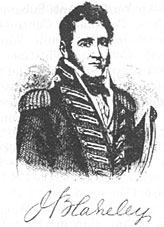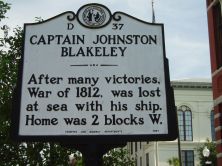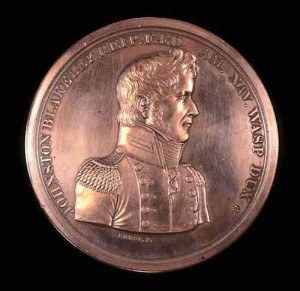U.S.S. Wasp – War of 1812 and the H.M.S. Reindeer
June 28, 2014 in American History, History
It’s important for those interested in the U.S.S. Wasp and its battles, to understand that when it comes to the naming of ships, the U.S.S. Wasp was not first ship to carry that name. In fact, it was actually the fifth ship to be named the Wasp (although internet searches will sometimes refer to it mistakenly as the second ship to be named thus). Going back in time slightly, it’s also important to remember that the American Navy was in its infancy having been born on 11 October 1775, when Congress decided that the Continental Navy (as it was known then) was authorized the first official ship of the United Colonies. Ship naming was haphazard until the later assignment of that duty to the Secretary of Navy, which wouldn’t occur until 1819. Our navy ships were named in honor of famous people, patriots, heroes, American cities and towns, positive character traits, and small creatures who packed a sting, such as insects – hence the popularity of the ship name “Wasp.” The Wasp was certainly a ship that lived up to the “sting” of its namesake.
During the War of 1812, the U.S.S. Wasp was built in 1813 by Cross & Merrill of Newburyport, Massachusetts and ready to launch by 1814. She was a fast moving sloop-of-war, meaning that she was a smaller square-rigged sailing warship with cannons on only one deck. The Wasp had twenty 32 pounder carronades and two long guns. She carried one hundred and seventy-three Marines and sailors. That crew was made up of almost entirely New Englanders of youthful age, averaging only 23 years of age. For many of them they had not previously been to sea but had on their side both enthusiasm and ambition. It would take a skilled and talented man to be in charge of them.
Her first and only commander was thirty-three year old, Irish born, Master Commandant Johnston Blakeley, who waited patiently in Portsmouth, New Hampshire until May 1st, 1814 for its first war cruise. This was not his first war time naval rodeo, as he had already earned his place in naval history on board the U.S.S. Enterprise in the splendid victory over the H.M.S. Boxer. He had had the perfect ingredients for commanding the Wasp. The destination was the English Channel.
More than a month before she was to engage the H.M.S. Reindeer in battle, she captured her first vessel, the Neptune which after taking her crew as prisoners, she promptly burned. Her next conquest was the William, and once again she burned that 91 ton brig as well. She would also scuttle the Pallas, the Henrietta, and scuttle the Orange Boven before she would encounter the H.M.S. Reindeer. He would write shortly after in a letter of July 8, 1814 that not every ship they encountered was prey:
“After arriving on soundings, the number of neutrals which were passing kept us almost constantly in pursuit. . . . I found it impossible to maintain anything like a station, and was led in chase farther up the Channel than was intended.”
The battle between the U.S.S. Wasp and the H.M.S Reindeer is recorded in history to have last only 19 minutes, but seldom is it mentioned that for two hours before the actually taking of the H.M.S. Reindeer, these two ships were engaged in a cat-and-mouse standoff and a bit of a chase. It was the Reindeer that fired the first 12 pound cannonade loaded with round and grape shot. Still, the U.S.S. Wasp did not immediately respond in turn, but instead, Commander Blakeley, put his helm alee; and only then returned fire, in succession, all the guns of his broadside as they bore. This caused the Reindeer to become somewhat disabled and run aboard of the Wasp, her port bow against the Wasp’s quarter, in which position the Wasp raked with telling effect.
This is the point in naval battle where the youthful crew of the American marines and riflemen with the marksmanship they were famed for, picked off many of the exposed officers and crew of the Reindeer. The captain of the H.M.S. Reindeer was among the wounded, but kept the deck and urged his crew on in the fight. A second wound soon went through his thighs and brought him to his knees, still he was said to have stood up, bleeding profusely, and shouted to his men:
“Follow me, my boys, we must board.”
With those words, it’s told that he climbed the rigging to lead them on, but two balls from the Wasp’s maintop instantly passed through his skull, and killed him. The sea battle action left the Wasp six round shot in her hull, and a 24-pound shot had passed through the center of her foremast, and her sails and rigging injured. Commander Blakeley would later write:
“The Reindeer was literally cut to pieces in a line with her ports.”
The Wasp lost five of its crew and twenty-one were ,wounded. The Reindeer lost twenty-five crew, and had forty-two wounded. The American take on this victory was that the crews were splendidly disciplined and both had the finest of leaders, but in the in that victory depends on something else than determination and courage; and in this case the fair conclusion was it was due to superiority in power. After the battle Blakeley set out to get care for his wounded and make needed repairs in L’Orient, France — where they remained for a month and went on to make six more valuable captures before arriving back safely in Savannah, Georgia, only to be lost at sea somewhere in the Caribbean a couple of weeks later. Commander Johnston Blakeley would be promoted to Captain after his death and the Medal of Honor was awarded to him. His widow was given by Congress a pension for the rest of her lifetime and also provided for the education of their child.



Recent Comments